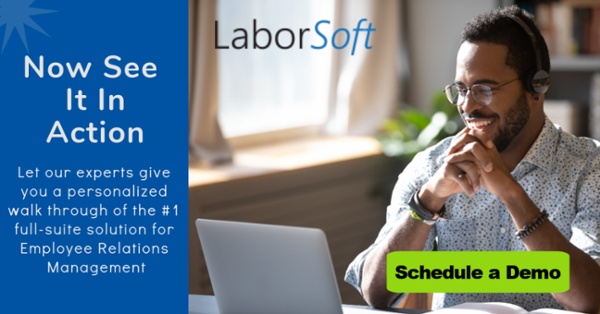Labor Relations | Compliance & Legal
Best Practices for Compliance and Labor Relations
Read Time 6 mins | Nov 24, 2025 | Written by: LaborSoft

Compliance and labor relations are deeply interconnected. You can’t have a stable, productive relationship with a union — or a satisfied non-union workforce for that matter — without a foundation of consistent, transparent compliance.
When HR teams follow established labor laws, maintain clear documentation, and communicate openly, they reduce risk while reinforcing trust. Amid the shifting sands of regulations and rising employee expectations, a closer look at internal processes is easily justified; the financial and reputational risks are great.
Consider that on a scale of 0 to 10, with 0 being the best and 10 the worst, the U.S. is currently ranked at a 3 in compliance with fundamental rights at work. This is behind Canada and most of Europe (0), and roughly in line with Russia (3). Employees can be protective and defensive about their rights in an environment where they don’t feel compliance is a given.
Avoiding penalties is not enough. Modern compliance strives to create systems and relationships that encourage fairness, accountability, and collaboration. Tools like LaborSoft help to make that possible. HR leaders can use technology to bridge the gap and unite compliance integrity with effective labor relations management.
Compliance and Labor Relations Are Inseparable
Compliance ensures that employee rights and contractual obligations are upheld with the utmost consistency. Labor relations, in turn, depend on that consistency to maintain credibility and mutual respect.
If compliance falters through incomplete documentation, delayed grievance responses, or missed arbitration deadlines, union trust erodes and labor disputes can escalate. Conversely, when HR demonstrates procedural fairness, it builds credibility and prevents conflicts from becoming crises.
A strong compliance program (especially when supported by technology and clear processes) serves as the backbone of positive labor relations.
4 Best Practices Every HR Team Should Follow
Success lies in your ability to build disciplined, transparent systems that integrate compliance and labor relations into one unified framework.
1. Document Everything
Grievances, investigations, arbitration agreements, negotiation outcomes… In all of these, documentation is your first line of defense and your best tool for transparency.
A robust digital record protects the organization during audits or disputes. It also shows good faith to employees and unions. LaborSoft Case Management Software allows HR teams to securely store every document in one centralized, searchable repository. Each entry is timestamped, version-controlled, and accessible only to authorized users. The layers of defense and accountability offer a permanent audit trail for every interaction.
2. Stay Current with Labor Laws
Federal and state labor laws can be expected to continue to evolve. Everything from overtime eligibility to parental leave, arbitration rights, and collective bargaining procedures is constantly in flux.
HR must regularly review updates from the Department of Labor, the National Labor Relations Board (NLRB), and state agencies to maintain compliance. Outdated policies often lead to unintentional violations or grievances that could have been prevented.
The LaborSoft platform helps mitigate that risk by linking policy libraries to case management workflows. When laws change, HR can update policies system-wide and apply them consistently across all active cases, ensuring alignment with the latest regulations.
3. Empower Compliance Officers
Compliance officers play a pivotal role in maintaining fairness and oversight, but they can’t do it effectively without visibility. Provide them with real-time dashboards and analytics so they can monitor case progress and flag anomalies for more timely resolution.
LaborSoft equips compliance officers with the tools they need to track HR investigations and identify patterns of risk. This might include recurring departmental disputes or repeated contract violations. Such insights empower proactive action before small issues escalate into larger conflicts.
4. Integrate Technology for Consistency
Manual compliance tracking is simply no longer sustainable. It’s often proven that paper files and spreadsheets leave too much room for error, inconsistency, and lost data.
A centralized labor management system like LaborSoft integrates all aspects of HR compliance from grievance management to arbitration documentation into a single platform. The system ensures data consistency and helps to enforce procedural timelines. The more your team can maintain a complete audit trail, the more your compliance process will stand up to both internal and external scrutiny.
This level of integration protects the organization legally and strengthens transparency between HR, unions, and leadership. Everyone operates from the same set of verified, up-to-date records.
A Culture of Accountability
When compliance is automated, consistent, and transparent, both HR and unions benefit. Employees feel confident that their rights are protected, while management gains assurance that procedures are followed correctly and defensibly.
Analytics tools bring that accountability to life by highlighting potential problem areas early — such as delayed grievance resolutions, departments with high complaint frequency, or recurring arbitration topics. This proactive insight allows HR to intervene before conflicts grow. Ultimately your organization fosters smoother negotiations and stronger overall labor relations.
Moreover, transparent compliance practices demonstrate respect for employee voices. When unions see that HR adheres to established processes, maintains documentation integrity, and follows through on commitments, they’re more likely to engage constructively rather than confrontationally.
Aligning Compliance with Collaboration
Compliance and collaboration are not opposing forces; they’re mutually reinforcing. HR must use technology to maintain accuracy and openness in order for labor relations to become more stable, productive, and fair.
LaborSoft helps organizations achieve that balance by combining data-driven compliance tools with intuitive case management workflows. The result is a workplace culture grounded in shared accountability.


